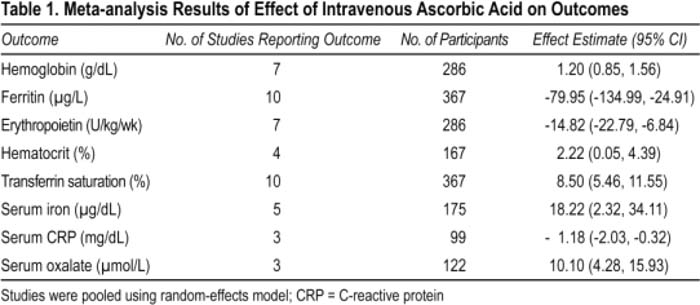Background:
High doses of erythropoietin and iron, usually required for the treatment of anemia in hemodialysis patients, are associated with longterm adverse consequences. Ascorbic acid, an antioxidant, can increase the available functional iron, decrease iron and erythropoietin requirements, and improve anemia. Results of clinical trials have been inconsistent. Therefore, we performed a meta‐analysis of clinical trials that examined the effect of intravenous ascorbic acid on anemia, iron indices, and erythropoietin requirement.
Methods:
We searched PubMed, EMBASE, and the Cochrane Central Register of Controlled Trials for relevant articles from the inception of these databases to November 2009. We also searched references of the included articles and public registries of clinical trials (clinicaltrials.gov and clinicalstudyresults.org) to identify missed trials. We included all controlled clinical trials, including crossover trials, that enrolled chronic hemodialysis patients and compared vitamin C with either a placebo or standard treatment and were published in an English‐language peer‐reviewed medical journal. Two reviewers independently abstracted data, and differences were resolved with mutual consensus. We used a random‐effects model to pool the results of individual studies.
Results:
Of the 318 studies identified through our search strategy, 13 studies enrolling 497 patients (median = 36 patients; range = 18‐61 patients) fulfilled inclusion criteria. Most patients enrolled in these studies were middle aged (mean age = 54 years), the majority were male (60%), and patients were on hemodialysis for about 5 years (mean = 58 months). Supplementation with intravenous ascorbic add was associated with increase in hemoglobin, hematocrit, transferrin saturation, and serum iron and decrease in erythropoietin dose, serum femtin. and C‐reactive protein (Table 1), On the other hand, serum oxalate levels increased in vitamin C‐treated patients.
Conclusions:
Intravenous ascorbic acid in hemodialysis patients increases iron availability and decreases erythropoietin dose. The clinical significance of the observed increase in serum oxalale in this population is unclear.
Author Disclosure:
J. Adomaityte, none; A. Farooq, none; R. Qayyum, none.

